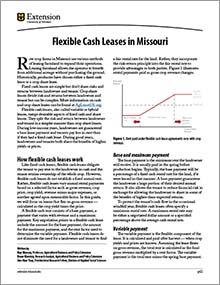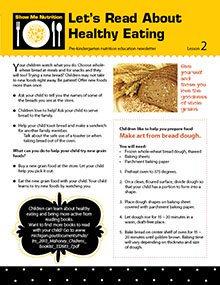

Let's Read About Healthy Eating — Newsletter for Pre-kindergarten Curriculum Lesson 4: Choosing Fruits and Vegetables (Bundle of 25)
Reviewed $12
Editor's note
The following abstract describes a publication that is available for purchase or as a downloadable PDF.
If reprinting or copying, please complete the permissions form that can be found on the reprint and copy guidelines page. If sharing or posting, please link directly to this page.

Building MyBody — Newsletter for Third Grade Curriculum Lesson 2: Carbohydrates (Bundle of 25)
Reviewed $12
Editor's note
The following abstract describes a publication that is available for purchase or as a downloadable PDF.
If reprinting or copying, please complete the permissions form that can be found on the reprint and copy guidelines page. If sharing or posting, please link directly to this page.

Flexible Cash Leases in Missouri
New
Explore how flexible cash leases balance risk and reward for landowners and tenants, offering a fairer alternative to fixed cash and crop share leases.

Fun With Food and Fitness — Newsletter for First Grade Curriculum Lesson 4: Vegetables (Bundle of 25)
Reviewed $12
Editor's note
The following abstract describes a publication that is available for purchase or as a downloadable PDF.
If reprinting or copying, please complete the permissions form that can be found on the reprint and copy guidelines page. If sharing or posting, please link directly to this page.

Let's Read About Healthy Eating — Newsletter for Pre-kindergarten Curriculum Lesson 6: Protein (Bundle of 25)
Reviewed $12
Editor's note
The following abstract describes a publication that is available for purchase or as a downloadable PDF.
If reprinting or copying, please complete the permissions form that can be found on the reprint and copy guidelines page. If sharing or posting, please link directly to this page.

Building MyBody — Newsletter for Third Grade Curriculum Lesson 5: Reading the Food Label (Bundle of 25)
Revised $12
Editor's note
The following abstract describes a publication that is available for purchase or as a downloadable PDF.
If reprinting or copying, please complete the permissions form that can be found on the reprint and copy guidelines page. If sharing or posting, please link directly to this page.

Fun With Food and Fitness — Newsletter for First Grade Curriculum Lesson 5: Fruits (Bundle of 25)
Reviewed $12.00
Editor's note
The following abstract describes a publication that is available for purchase or as a downloadable PDF.
If reprinting or copying, please complete the permissions form that can be found on the reprint and copy guidelines page. If sharing or posting, please link directly to this page.

Let's Read About Healthy Eating — Newsletter for Pre-kindergarten Curriculum Lesson 9: Beans (Bundle of 25)
Reviewed $12
Editor's note
The following abstract describes a publication that is available for purchase or as a downloadable PDF.
If reprinting or copying, please complete the permissions form that can be found on the reprint and copy guidelines page. If sharing or posting, please link directly to this page.

Choosing Foods for Me — Newsletter for Fourth Grade Curriculum Lesson 1: Grains, fruits and vegetables (Bundle of 25)
Reviewed $12
Editor's note
The following abstract describes a publication that is available for purchase or as a downloadable PDF.
If reprinting or copying, please complete the permissions form that can be found on the reprint and copy guidelines page. If sharing or posting, please link directly to this page.

Adventures in Nutrition With the Show Me Chef — Newsletter for Kindergarten Curriculum Lesson 3: Whole Grains (Bundle of 25)
Reviewed $12
Editor's note
The following abstract describes a publication that is available for purchase or as a downloadable PDF.
If reprinting or copying, please complete the permissions form that can be found on the reprint and copy guidelines page. If sharing or posting, please link directly to this page.

Choosing Foods for Me — Newsletter for Fourth Grade Curriculum Lesson 4: What's on a Label? (Bundle of 25)
Revised $12
Editor's note
The following abstract describes a publication that is available for purchase or as a downloadable PDF.
If reprinting or copying, please complete the permissions form that can be found on the reprint and copy guidelines page. If sharing or posting, please link directly to this page.

Fun With Food and Fitness — Newsletter for First Grade Curriculum Lesson 7: Protein (Bundle of 25)
Reviewed $12
Editor's note
The following abstract describes a publication that is available for purchase or as a downloadable PDF.
If reprinting or copying, please complete the permissions form that can be found on the reprint and copy guidelines page. If sharing or posting, please link directly to this page.

Choosing Foods for Me - Newsletter for Fourth Grade Curriculum Lesson 7: Eating Out (Bundle of 25)
Revised $12
Editor's note
The following abstract describes a publication that is available for purchase or as a downloadable PDF.
If reprinting or copying, please complete the permissions form that can be found on the reprint and copy guidelines page. If sharing or posting, please link directly to this page.

Food Group Express — Newsletter for Second Grade Curriculum Lesson 2: Whole Grains (Bundle of 25)
Reviewed $12
Editor's note
The following abstract describes a publication that is available for purchase or as a downloadable PDF.
If reprinting or copying, please complete the permissions form that can be found on the reprint and copy guidelines page. If sharing or posting, please link directly to this page.

Choosing Foods for Me — Newsletter for Fourth Grade Curriculum Lesson 10: Hunger (Bundle of 25)
Reviewed $12
Editor's note
The following abstract describes a publication that is available for purchase or as a downloadable PDF.
If reprinting or copying, please complete the permissions form that can be found on the reprint and copy guidelines page. If sharing or posting, please link directly to this page.

Food Group Express — Newsletter for Second Grade Curriculum Lesson 5: Dairy (Bundle of 25)
Revised $12
Editor's note
The following abstract describes a publication that is available for purchase or as a downloadable PDF.
If reprinting or copying, please complete the permissions form that can be found on the reprint and copy guidelines page. If sharing or posting, please link directly to this page.

Exploring the Food Groups — Newsletter for Fifth Grade Curriculum Lesson 3: Reading the Nutrition Facts Label (Bundle of 25)
Reviewed $12
Editor's note
The following abstract describes a publication that is available for purchase or as a downloadable PDF.
If reprinting or copying, please complete the permissions form that can be found on the reprint and copy guidelines page. If sharing or posting, please link directly to this page.

Adventures in Nutrition With the Show Me Chef — Newsletter for Kindergarten Curriculum Lesson 5: Fruit (Bundle of 25)
Reviewed $12
Editor's note
The following abstract describes a publication that is available for purchase or as a downloadable PDF.
If reprinting or copying, please complete the permissions form that can be found on the reprint and copy guidelines page. If sharing or posting, please link directly to this page.

Adventures in Nutrition With the Show Me Chef — Newsletter for Kindergarten Curriculum Lesson 1: Hand Washing (Bundle of 25)
Reviewed $12
Editor's note
The following abstract describes a publication that is available for purchase or as a downloadable PDF.
If reprinting or copying, please complete the permissions form that can be found on the reprint and copy guidelines page. If sharing or posting, please link directly to this page.

Exploring the Food Groups — Newsletter for Fifth Grade Curriculum Lesson 6: Fruits (Bundle of 25)
Reviewed $12
Editor's note
The following abstract describes a publication that is available for purchase or as a downloadable PDF.
If reprinting or copying, please complete the permissions form that can be found on the reprint and copy guidelines page. If sharing or posting, please link directly to this page.

Exploring the Food Groups — Newsletter for Fifth Grade Curriculum Lesson 9: Snacks (Bundle of 25)
Reviewed $12
Editor's note
The following abstract describes a publication that is available for purchase or as a downloadable PDF.
If reprinting or copying, please complete the permissions form that can be found on the reprint and copy guidelines page. If sharing or posting, please link directly to this page.

Adventures in Nutrition With the Show Me Chef — Newsletter for Kindergarten Curriculum Lesson 6: Dairy (Bundle of 25)
Reviewed $12
Editor's note
The following abstract describes a publication that is available for purchase or as a downloadable PDF.
If reprinting or copying, please complete the permissions form that can be found on the reprint and copy guidelines page. If sharing or posting, please link directly to this page.

Lets Read About Healthy Eating — Newsletter for Pre-kindergarten Curriculum Lesson 2: Breads (Bundle of 25)
Reviewed $12
Editor's note
The following abstract describes a publication that is available for purchase or as a downloadable PDF.
If reprinting or copying, please complete the permissions form that can be found on the reprint and copy guidelines page. If sharing or posting, please link directly to this page.

Let's Read About Healthy Eating — Newsletter for Pre-kindergarten Curriculum Lesson 1: Hand Washing (Bundle of 25)
Revised $12
Editor's note
The following abstract describes a publication that is available for purchase or as a downloadable PDF.
If reprinting or copying, please complete the permissions form that can be found on the reprint and copy guidelines page. If sharing or posting, please link directly to this page.

Building MyBody — Newsletter for Third Grade Curriculum Lesson 1: Getting to know MyPlate (Bundle of 25)
Reviewed $12
Editor's note
The following abstract describes a publication that is available for purchase or as a downloadable PDF.
If reprinting or copying, please complete the permissions form that can be found on the reprint and copy guidelines page. If sharing or posting, please link directly to this page.